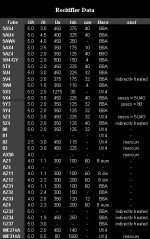After reading for 2 days to familiarize myself on the subject of Rectifier Tubes, I compiled all kind of usefull informations on a quick reference sheet. I tried to be as accurate as possible.
In hope it can be of some use to other peoples...
In hope it can be of some use to other peoples...

Attachments
Good idea, but I think you might want to make a few changes to remarks in the document. I have not necessarily checked all other assertions for accuracy.
Just because the 5Y3 uses a direct heated filament does not make it any noisier than a 5AR4, in fact arguably this is irrelevant as the 5AR4 cathode is tied to one end of the filament. In some applications direct heated rectifiers use center tapped filament transformers and any small theoretical 60Hz component in the output would be totally nulled. Note that since the filament current loop and load current loops are essentially independent you shouldn't really see any 60Hz component in the output anyway.
Also note that I have 5Y3 that are both direct heated and some indirect heated like the 5AR4.
5AR4 has a much higher continuous current rating (250mA) than the 5Y3 (125mA) so you are contradicting yourself in the description. I wouldn't consider the 5AR4 a low current rectifier - it's not. It was very commonly used in power amplifiers like the Dynaco ST-70, MKII, MKIII, MKIV, Avantic Beam Echo, Leak, Quad, most HH Scott, and so many other amplifiers I can't even begin to list them.
I think fans of the WE274 and many others would argue violently with you about your assertion that the 5AR4 is the best rectifier ever. Basically that is a groundless assertion. Modern ones are pretty poor performers compared to vintage Mullard/Teles or anything else I can think of. It does have one of the lowest forward drops of commonly used rectifiers and a long warm up time constant that is dht friendly. (Again most modern ones do not have quite as low a forward drop under load as the vintage ones do, this observed by comparison in the same amp under the same conditions.)
Note that most damper rectifiers have equally long warm up constants, lower drop under load, much higher voltage ratings and in some instances higher current capacity as well.
I have not closely checked the veracity of your technical data, so others may find minor issues there as well. Still I think this is a useful document and I would encourage you to add to it as you get more exposure to other rectifiers.
Check out the 274A/B, 6BY5, EZ80, EZ81, GZ32, GZ37, 5R4, 5U4, and the 6AU4GTA as other useful types.
Edited: Heavily 😉
Just because the 5Y3 uses a direct heated filament does not make it any noisier than a 5AR4, in fact arguably this is irrelevant as the 5AR4 cathode is tied to one end of the filament. In some applications direct heated rectifiers use center tapped filament transformers and any small theoretical 60Hz component in the output would be totally nulled. Note that since the filament current loop and load current loops are essentially independent you shouldn't really see any 60Hz component in the output anyway.
Also note that I have 5Y3 that are both direct heated and some indirect heated like the 5AR4.
5AR4 has a much higher continuous current rating (250mA) than the 5Y3 (125mA) so you are contradicting yourself in the description. I wouldn't consider the 5AR4 a low current rectifier - it's not. It was very commonly used in power amplifiers like the Dynaco ST-70, MKII, MKIII, MKIV, Avantic Beam Echo, Leak, Quad, most HH Scott, and so many other amplifiers I can't even begin to list them.
I think fans of the WE274 and many others would argue violently with you about your assertion that the 5AR4 is the best rectifier ever. Basically that is a groundless assertion. Modern ones are pretty poor performers compared to vintage Mullard/Teles or anything else I can think of. It does have one of the lowest forward drops of commonly used rectifiers and a long warm up time constant that is dht friendly. (Again most modern ones do not have quite as low a forward drop under load as the vintage ones do, this observed by comparison in the same amp under the same conditions.)
Note that most damper rectifiers have equally long warm up constants, lower drop under load, much higher voltage ratings and in some instances higher current capacity as well.
I have not closely checked the veracity of your technical data, so others may find minor issues there as well. Still I think this is a useful document and I would encourage you to add to it as you get more exposure to other rectifiers.
Check out the 274A/B, 6BY5, EZ80, EZ81, GZ32, GZ37, 5R4, 5U4, and the 6AU4GTA as other useful types.
Edited: Heavily 😉
Thanks for the comments, very interesting. I got most of the Data from the web and numerous datasheet from Duncan Amps site: http://tdsl.duncanamps.com
I'm still a tube newbie, but I'm learning. Since I needed a tube rectifier for my current project, I tried to compile info on the rectifiers that I knew and found on some current designs.
Here a new version with new comments and an other tube, the EZ81.
Thanks Mas Penk for the chart.
I'm still a tube newbie, but I'm learning. Since I needed a tube rectifier for my current project, I tried to compile info on the rectifiers that I knew and found on some current designs.
Here a new version with new comments and an other tube, the EZ81.
Thanks Mas Penk for the chart.
Attachments
- Status
- Not open for further replies.
